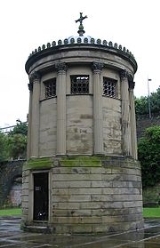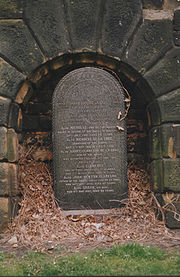
St James Cemetery
Encyclopedia


Urban park
An urban park, is also known as a municipal park or a public park, public open space or municipal gardens , is a park in cities and other incorporated places to offer recreation and green space to residents of, and visitors to, the municipality...
behind the Liverpool Cathedral
Liverpool Cathedral
Liverpool Cathedral is the Church of England cathedral of the Diocese of Liverpool, built on St James's Mount in Liverpool and is the seat of the Bishop of Liverpool. Its official name is the Cathedral Church of Christ in Liverpool but it is dedicated to Christ and the Blessed Virgin...
that is below ground level. Until 1825, the space was a stone quarry, and until 1936 it was used as the Liverpool
Liverpool
Liverpool is a city and metropolitan borough of Merseyside, England, along the eastern side of the Mersey Estuary. It was founded as a borough in 1207 and was granted city status in 1880...
city cemetery
Cemetery
A cemetery is a place in which dead bodies and cremated remains are buried. The term "cemetery" implies that the land is specifically designated as a burying ground. Cemeteries in the Western world are where the final ceremonies of death are observed...
. It has been designated a Grade I Historic Park by English Heritage
English Heritage
English Heritage . is an executive non-departmental public body of the British Government sponsored by the Department for Culture, Media and Sport...
.
History
The workings and operation of the cemetery predate the Cathedral to which it does not belong. The Cathedral, which began construction in 1903, occupies most of rock outcrop above the cemetery known as St James Mount (also known as Quarry Hill or Mount Zion) that in 1771 was established as Liverpool's first public park.The cemetery has two entrances which are always open. At the north side a stone path lined with recycled grave stones descends through a short tunnel between The Oratory
The Oratory
The Oratory stands to the north of Liverpool Cathedral in Merseyside, England. It was originally the mortuary chapel to St James Cemetery, and houses a collection of sculpture. It has been designated by English Heritage as a Grade I listed building....
and the main entrance of the cathedral. The southern entrance near Upper Parliament street
A562 road
The A562 is a road in England which runs from Liverpool to Warrington.At Liverpool the road is known at first as Parliament Street, then Upper Parliament Street, Smithdown Road, Allerton Road, Menlove Avenue, Hillfoot Road, Hillfoot Avenue and Higher Road, before joining Speke Boulevard.It ends in...
is through a stone arch between the Garden Lodge and the steps up to the Mount. Notable features include the Huskisson
William Huskisson
William Huskisson PC was a British statesman, financier, and Member of Parliament for several constituencies, including Liverpool...
memorial, a natural spring and a system of broad ramps lined with catacombs. There is no access from Hope Street
Hope Street, Liverpool
Hope Street, Liverpool, England stretches from Liverpool Metropolitan Cathedral past Liverpool Cathedral to Upper Parliament Street. It contains several restaurants, hotels and bars. The road runs parallel to Rodney Street...
.
The quarry
The original stone quarry began operation in the 16th century.http://www.stjamescemetery.co.uk/history.htm The tunnel workings (most of which are blocked) probably happened in the 18th century.http://www.stjamescemetery.co.uk/tunnel.htm In 1773 the quarry workers discovered a running spring,http://www.stjamescemetery.co.uk/spring.htm which still flows today.There were windmill
Windmill
A windmill is a machine which converts the energy of wind into rotational energy by means of vanes called sails or blades. Originally windmills were developed for milling grain for food production. In the course of history the windmill was adapted to many other industrial uses. An important...
s in operation at the edge of the quarry until the 1820s.
The quarry was exhausted in 1825.http://www.stjamescemetery.co.uk/history.htm
The cemetery
In 1826 the young architect John Foster JrJohn Foster (architect)
John Foster, Junior was an English architect.-Biography:Foster studied under Jeffry Wyatt in London and in 1809 travelled in the eastern Mediterranean. During 1810-11 he accompanied C. R. Cockerell and the German archaeologists Haller and Linckh in their excavation of the temples at Aegina and...
was commissioned to design and lay out a cemetery along the same lines as Père Lachaise Cemetery
Père Lachaise Cemetery
Père Lachaise Cemetery is the largest cemetery in the city of Paris, France , though there are larger cemeteries in the city's suburbs.Père Lachaise is in the 20th arrondissement, and is reputed to be the world's most-visited cemetery, attracting hundreds of thousands of visitors annually to the...
, Paris
Paris
Paris is the capital and largest city in France, situated on the river Seine, in northern France, at the heart of the Île-de-France region...
with £20,000 raised by public subscription.http://www.stjamescemetery.co.uk/history.htm
The OratoryThe OratoryThe Oratory stands to the north of Liverpool Cathedral in Merseyside, England. It was originally the mortuary chapel to St James Cemetery, and houses a collection of sculpture. It has been designated by English Heritage as a Grade I listed building....
On the high ground at the north Foster built the windowless Oratory in the style of Greek Revival architectureGreek Revival architecture
The Greek Revival was an architectural movement of the late 18th and early 19th centuries, predominantly in Northern Europe and the United States. A product of Hellenism, it may be looked upon as the last phase in the development of Neoclassical architecture...
to accommodate funeral services before burials took place in the cemetery.http://www.stjamescemetery.co.uk/oratory.htmhttp://www.stjamescemetery.co.uk/olddraw.htm
The building today, which is infrequently open to the public, contains a number of the monumental statutes recovered from the cemetery. A bronze sculpture by Tracey Emin
Tracey Emin
Tracey Karima Emin RA is a British artist of English and Turkish Cypriot origin. She is part of the group known as Britartists or YBAs ....
stands in front of the building and is visible through the gates.http://news.bbc.co.uk/2/hi/uk_news/england/merseyside/4293245.stm
There was also a house for the minister, of which there is no trace, on the site of the cathedral.http://www.stjamescemetery.co.uk/history.htm
The Garden Lodge
To the south, Foster built a monumental arch and porter's lodge out of the same stone.http://www.stjamescemetery.co.uk/history.htmAfter years of being used as a property of the council for its workmen, it was refurbished into a private home in 1997.http://www.goatchurch.org.uk/homeview/homeview1/homeview1.html
The burial grounds
The cemetery was closed in 1936 after 57,774 burials and subsequently fell into a state of disrepair.http://www.stjamescemetery.co.uk/history.htmThe monument above where William Huskisson
William Huskisson
William Huskisson PC was a British statesman, financier, and Member of Parliament for several constituencies, including Liverpool...
is buried stands near the spring.http://www.historyhome.co.uk/peel/people/huskisso.htm

